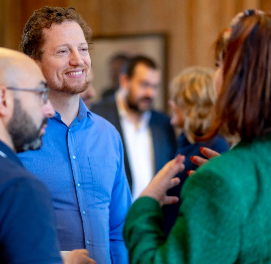Leading a business has never been easy but the events of the last few months have been more challenging than anyone could have predicted. For those sitting at board level, striving to steer their organisations through the changes that have resulted from the COVID-19 crisis, it has been a time of rapid and unprecedented learning.
As leadership coaches and consultants working with a range of organisations around the world, the team at TPC Leadership have seen first hand the impact the crisis has had. Over the last few weeks, our managing partners have been getting together virtually to discuss the key issues in a series of panel discussions.
In this week’s blog post, we join TPCL founder Charles Brook and managing partners Paula Abramovicz Erlich (Brazil), Frouke Horstmann (Netherlands), and Laurent Jacquet (Belgium) as they look at the role culture plays within a business, how it has become even more strategically significant thanks to the pandemic, and what leaders at board level can do to ensure they set and communicate an effective culture within their organisations.
- Change, communication and employee retention
Most people don’t like change, especially when it might impact their security. When the pandemic hit, a lot of people were naturally very frightened. From how to adapt to home working to the worries or whether or not they’d have a job by the end of the year, employees had a lot of questions. In many cases these questions remain unanswered. And for business leaders this can have a negative impact on morale, productivity and ultimately retention.
Frouke Horstmann and Laurent Jacquet, managing partners for the Netherlands and Belgium respectively, have recently worked with a client on a culture project. Concerned about the number of people leaving the business, they asked TPCL to help them understand why people might be leaving.
The answer was simple: lack of communication. Despite having all the right intentions to communicate their plans, the leadership team had been holding back until they had all the answers. Ultimately they had decided not to let anyone go – but in the meantime, people had been scared of losing their jobs and so had decided to move on.
“The younger population – the whole world – is 24/7 these days, communication is 24/7,” says Frouke. “So even if you don’t know the answers, you have to be communicating with people, you have to let them know as far as you can what you already know, what you don’t know, what your ideas are.”
And it’s not enough to communicate practical plans either. In times of crisis the temptation is to focus on operations and ignore strategy, but setting and communicating an organisational vision is especially important when everything else is so uncertain.
“There has to be a reason for people to want to stay,” says Charles Brook. “And organisations that don’t help people connect with what they’re doing, to the reason why the organisation is there and why they as individuals are there – that meaning and purpose – are really going to struggle.”
This is particularly important in a work-from-home context, where staying connected to an organisation, its vision and its culture is that much harder. People need to know that the effort they’re making has an impact and that they have a place within a wider context.
Charles adds: “Many organisations are understandably trying to leverage performance and productivity when it comes to home working, but they sometimes don’t realise that another cost is people disconnecting. To attract and retain talent it’s important that they feel connected.”
- Protecting connection and culture in a virtual world
There are benefits to remote working when it comes to talent. Without the need for people to be physically present in an office, employers can widen the net, hiring from further afield – even abroad. The accelerated new ways of working have also opened people up to different hiring approaches.
Frouke says: “The discussions CHROs are now having is, ‘Okay, maybe we don’t need to always have people on the payroll. We can think in project terms and we can take that talent for six weeks, for two days and we can bring in someone from Singapore and someone from China and someone from Amsterdam, because they have the talents that we need now.’”
But attraction and retention remain a factor. With teams not coming together physically, how can employers ensure there is a consistent and effective culture? How do we get people to buy into an organisation and gain a sense of belonging if they work every day in their own home?
“With everyone working from home we’re just having meetings, we don’t talk around the water cooler,” says Paula Abramovicz Erlich. “There’s no spontaneity. Nothing comes around of meeting in the halls and having a spontaneous idea. There’s no chit-chat in the beginning of meetings, we always go straight to the point. So what happens to culture?”
Further reading: Employees working partially from home and in the office: how do you connect your team? By Frouke Horstmann
- Can culture be created – and if so, how?
For the leaders in charge of newly remote organisations, the issue of culture leads to two foundational questions – is it something that can be created and, if so, who is actually in control of that process?
Laurent Jacquet believes there are only two options – either you do nothing and a culture develops organically, or you decide on the culture you want and you communicate that down through the business.
“What are our values? How do we want to communicate? How do we want to take decisions? How do we want to work from home? Setting culture is about all of these things,” he says.
“For me, culture should be top-down – but you should of course be inclusive and listen to what everyone is saying in terms of their interpretation of the culture. My belief is that culture stems from the founder.”
In large organisations putting that into practice takes effort – especially where teams are split across different locations. If a board is setting a culture behind closed doors but failing to communicate that then it simply won’t be effective.
“It’s always down to the leadership,” says Paula. “The leadership needs to role model what the culture is, what they want everyone else in the company to do. So if the board doesn’t get the leadership on board, there is no culture change, in my view.”
Role modelling is a vital part of leading when it comes to culture. Frouke, who has written extensively on workplace culture, has worked with a number of board level clients who want to set a feedback culture, for example, but don’t include themselves within the project.
“They want to have a program starting with what I call N-1 – so starting with a level below the board,” she says.
“I find that it is fascinating. If you want to have a feedback culture, is it not the most important thing that you look into the mirror yourself? And that you role model it to the rest of the organisation?”
- Communicating and developing culture
Whether a board allows a culture to emerge organically or whether they are constructionist about it and create it from the top, it is vital that it is clear what behaviours are acceptable in order to reinforce that culture.
“In some ways that’s the most important bit,” says Charles. “People need to know what is the right thing and the wrong thing to do in this culture. Otherwise, it’s very hard to get a unifying culture because people will act in different ways.
“We had a partner years ago who was probably one of the best at selling projects, so a very valuable person to have in the business. He wanted to become a senior partner but we have an annual values check where we assess whether our partners live their values and he didn’t pass that so we didn’t promote him. Eventually they had to leave.
“At one level you think, ‘We’re letting go of our best salesperson!’ but on another level if their behaviors are not going to generate the culture you want, then they have to go. And I think making some of those tough decisions is difficult for organisations but ultimately understanding what’s acceptable and not and then acting on it is really important.”
Culture has always been an important part of business success, bringing employees together, encouraging collaboration, improving morale, reducing turnover and having many other positive effects besides.
But in today’s business environment, with so much change and uncertainty, it is more important than ever. For board members and seniors leaders at the helm of their organisations, it is essential that steering the ship does not take priority over setting a course and communicating it to the crew.
Have you enjoyed this article? Be sure to catch up on the rest of the series:
Contact us for a discussion.
@copyright TPCL (2020)





